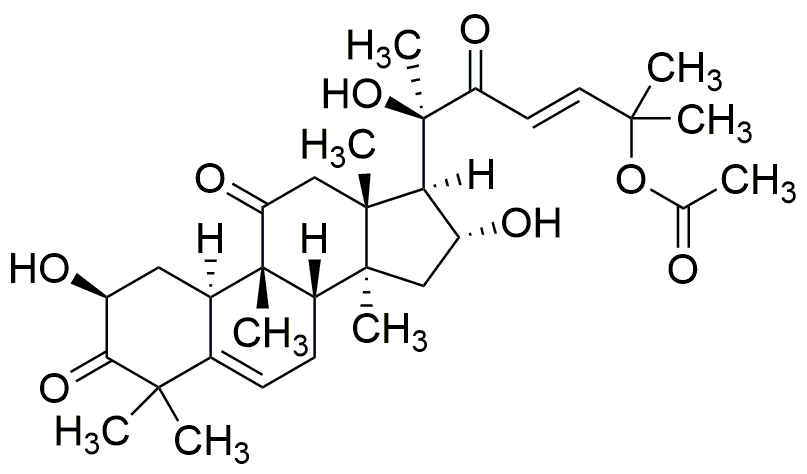Cucurbitacin B is widely utilized in research focused on:
- Pharmaceutical Development: This compound has shown potential in developing anti-cancer therapies due to its ability to inhibit cell proliferation and induce apoptosis in various cancer cell lines.
- Anti-inflammatory Applications: Cucurbitacin B exhibits anti-inflammatory properties, making it a candidate for formulating treatments for chronic inflammatory diseases, such as arthritis.
- Natural Pest Control: In agriculture, it serves as a natural pesticide, helping to manage pest populations without the use of synthetic chemicals, thus promoting sustainable farming practices.
- Neuroprotective Research: Studies suggest that this compound may offer neuroprotective effects, indicating its potential in treating neurodegenerative diseases like Alzheimer’s and Parkinson’s.
- Cosmetic Formulations: Its antioxidant properties make it valuable in cosmetic products aimed at reducing skin aging and improving overall skin health.
Informations générales
Propriétés
Sécurité et réglementation
Applications
Cucurbitacin B is widely utilized in research focused on:
- Pharmaceutical Development: This compound has shown potential in developing anti-cancer therapies due to its ability to inhibit cell proliferation and induce apoptosis in various cancer cell lines.
- Anti-inflammatory Applications: Cucurbitacin B exhibits anti-inflammatory properties, making it a candidate for formulating treatments for chronic inflammatory diseases, such as arthritis.
- Natural Pest Control: In agriculture, it serves as a natural pesticide, helping to manage pest populations without the use of synthetic chemicals, thus promoting sustainable farming practices.
- Neuroprotective Research: Studies suggest that this compound may offer neuroprotective effects, indicating its potential in treating neurodegenerative diseases like Alzheimer’s and Parkinson’s.
- Cosmetic Formulations: Its antioxidant properties make it valuable in cosmetic products aimed at reducing skin aging and improving overall skin health.
Documents
Fiches de données de sécurité (FDS)
La FDS fournit des informations de sécurité complètes sur la manipulation, le stockage et l’élimination du produit.
Spécifications du produit (PS)
Le PS fournit une description complète des propriétés du produit, notamment sa composition chimique, son état physique, sa pureté et les exigences de stockage. Il détaille également les plages de qualité acceptables et les applications prévues du produit.
Certificats d'analyse (COA)
Recherchez des certificats d'analyse (COA) en saisissant le numéro de lot du produit. Les numéros de lot et de lot se trouvent sur l'étiquette d'un produit, après les mots « Lot » ou « Lot de fabrication ».
Numéro de catalogue
Numéro de lot/série
Certificats d'origine (COO)
Ce certificat d'exploitation confirme le pays dans lequel le produit a été fabriqué, et détaille également les matériaux et composants utilisés et s'il est issu de sources naturelles, synthétiques ou autres sources spécifiques. Ce certificat peut être requis pour les douanes, le commerce et la conformité réglementaire.
Numéro de catalogue
Numéro de lot/série
Fiches de données de sécurité (FDS)
La FDS fournit des informations de sécurité complètes sur la manipulation, le stockage et l’élimination du produit.
DownloadSpécifications du produit (PS)
Le PS fournit une description complète des propriétés du produit, notamment sa composition chimique, son état physique, sa pureté et les exigences de stockage. Il détaille également les plages de qualité acceptables et les applications prévues du produit.
DownloadCertificats d'analyse (COA)
Recherchez des certificats d'analyse (COA) en saisissant le numéro de lot du produit. Les numéros de lot et de lot se trouvent sur l'étiquette d'un produit, après les mots « Lot » ou « Lot de fabrication ».
Numéro de catalogue
Numéro de lot/série
Certificats d'origine (COO)
Ce certificat d'exploitation confirme le pays dans lequel le produit a été fabriqué, et détaille également les matériaux et composants utilisés et s'il est issu de sources naturelles, synthétiques ou autres sources spécifiques. Ce certificat peut être requis pour les douanes, le commerce et la conformité réglementaire.


